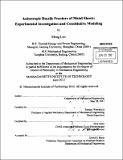| dc.contributor.advisor | Tomasz Wierzbicki. | en_US |
| dc.contributor.author | Luo, Meng, Ph. D. Massachusetts Institute of Technology | en_US |
| dc.contributor.other | Massachusetts Institute of Technology. Dept. of Mechanical Engineering. | en_US |
| dc.date.accessioned | 2012-11-19T19:32:13Z | |
| dc.date.available | 2012-11-19T19:32:13Z | |
| dc.date.copyright | 2012 | en_US |
| dc.date.issued | 2012 | en_US |
| dc.identifier.uri | http://hdl.handle.net/1721.1/74983 | |
| dc.description | Thesis (Ph. D.)--Massachusetts Institute of Technology, Dept. of Mechanical Engineering, 2012. | en_US |
| dc.description | Cataloged from PDF version of thesis. | en_US |
| dc.description | Includes bibliographical references (p. 296-311). | en_US |
| dc.description.abstract | Anisotropic mechanical properties are common in plastically deformed or thermomechanically processed metallic materials, e.g. in rolled or extruded sheet. Among them, the anisotropy of large strain plastic deformation and ductile fracture under multi-axial loading is highly relevant to various industrial applications such as metal forming, impact failure of structures, etc. In this thesis, a comprehensive study of the plasticity and ductile fracture of anisotropic metal sheets is presented, covering experimental characterization, constitutive modeling and numerical implementation. On the basis of an extensive multiaxial experimental program, the anisotropic plasticity of the present aluminum alloy is modeled using a macroscopic phenomenological model and a polycrystalline plasticity model, respectively. The proposed phenomenological modeling makes use of a linear-transformation- based orthotropic yield function with pressure dependence, as well as a combined isotropic/kinematic hardening law, and is able to capture most features of the anisotropic plastic behavior under various multi-axial stress states with good accuracy and computational efficiency. At the same time, a physically-motivated self-consistent polycrystalline plasticity model is utilized to describe the texture-induced anisotropy and through-thickness heterogeneity of the present sheet material. A Reduced Texture Methodology (RTM) is developed to provide the computational efficiency needed for industrial applications. In additional to an accurate prediction of all macroscopic material behaviors, the polycrystalline model reveals that the development of the crystallographic texture is the underlying mechanism of plastic anisotropy and heterogeneity. The anisotropic ductile fracture of the present aluminum alloy extrusion is investigated using a hybrid experimental-numerical approach. The experimental results show a strong dependency of the strain to fracture on the material orientation with respect to the loading direction. A new non-associated anisotropic fracture model is proposed which makes use of a stress state dependent fracture locus and an anisotropic plastic strain measure obtained through the linear transformation of the plastic strain tensor. It is shown that the use of the Modified Mohr-Coulomb (MMC) stress state weighting function in this anisotropic fracture modeling framework provides accurate predictions of the onset of fracture for all fourteen distinct fracture experiments. The proposed plasticity and fracture modeling framework is successfully validated on a industrial stretch-bending operation. | en_US |
| dc.description.statementofresponsibility | by Meng Luo. | en_US |
| dc.format.extent | 311 p. | en_US |
| dc.language.iso | eng | en_US |
| dc.publisher | Massachusetts Institute of Technology | en_US |
| dc.rights | M.I.T. theses are protected by
copyright. They may be viewed from this source for any purpose, but
reproduction or distribution in any format is prohibited without written
permission. See provided URL for inquiries about permission. | en_US |
| dc.rights.uri | http://dspace.mit.edu/handle/1721.1/7582 | en_US |
| dc.subject | Mechanical Engineering. | en_US |
| dc.title | Anisotropic ductile fracture of metal sheets : experimental investigation and constitutive modeling | en_US |
| dc.type | Thesis | en_US |
| dc.description.degree | Ph.D. | en_US |
| dc.contributor.department | Massachusetts Institute of Technology. Department of Mechanical Engineering | |
| dc.identifier.oclc | 815449055 | en_US |
